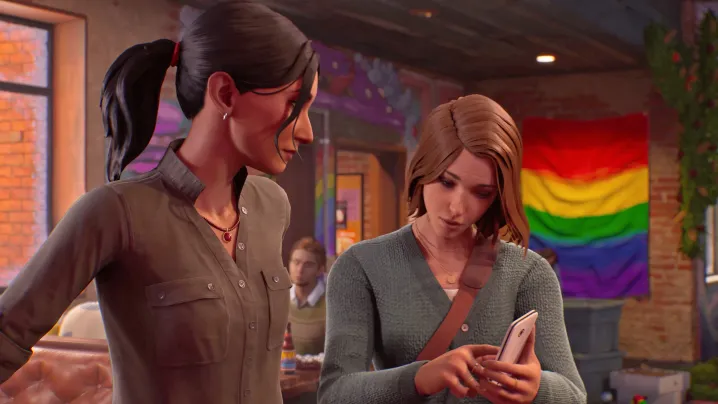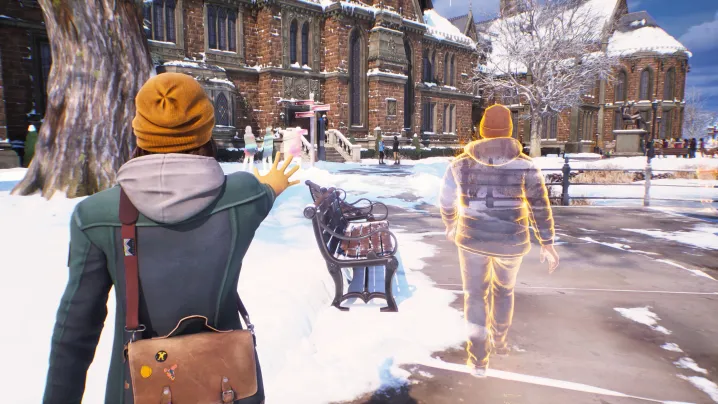
Life is Strange: Double Exposure
MSRP $50.00

Pros
- Emotional, relatable story
- Excellent performances
- Gorgeous visuals
- Maintains the series' distinct charm
Cons
- Unambitious gameplay
- Unsatisfying aspects of the ending
Sometimes, a video game can feel like it was made just for you. Even though that’s obviously not the case with Life is Strange: Double Exposure, which is part of a well-known franchise and spent years in development, I still can’t help but feel like that way.
As an anxious high schooler, I played the original Life is Strange and identified a lot with Max Caulfield’s journey then. Now, I’m playing this very self-reflective follow-up set on a campus as I’m returning to college myself to get a Master’s Degree and thinking about where my life has gone since my undergrad days.
I was worried another Life is Strange game starring Max Caulfield would feel like an unnecessary retread of worn ground. Instead, it’s a warm blanket that reminds me of why I fell in love with the series in the first place. Double Exposure’s gameplay isn’t anything special, but Max’s emotional journey is something I can deeply relate to and affirms that developer Deck Nine understands why the original resonated with people like myself a decade ago.
Max is back
Life is Strange: Double Exposure takes place around a decade after the events of the first Life is Strange. That game ended with players making a choice; they either had to kill Chloe to stop Arcadia Bay from being destroyed by a storm or let Chloe live at the cost of that town. A decade after the fact, Max is still living with the consequences of whichever choice she’s picked after spending lots of time on the road. She’s now a teacher at the prestigious Caledon University and has made plenty of new friends, but she still harbors resentment toward her powers and past choices.
Continuing Max Caulfield’s story offers me a warm blanket that I didn’t know I needed …
There has been some controversy within the community over the fact that this game implies that Max and Chloe broke up if she lived or that she was just a high school sweetheart if she died. I don’t mind this choice because Max’s failure to process and handle what happened in a healthy way is a core part of her emotional arc in Double Exposure. After her friend, Safi, is murdered, Max discovers she has the power to travel between timelines where she’s alive and dead.
This gives Max a pathway to prevent Safi’s murder as she could have for Chloe, but it also digs up old trauma and forces Max to become more secretive and removed from the people who care about her most. Double Exposure is all about how people are forced to live with the consequences of their actions, past trauma, and even the death of loved ones that they have no control over. That may all sound very dire, but Double Exposure still leaves room for wit and optimism.
 Square Enix
Square EnixIts writing can still be cheesy, but that now comes off as less Tumblr-coded and more like adults speaking without worrying what other people will think of them. Toss in an excellent soundtrack, and Double Exposure creates a vibe that feels not dissimilar from my own adult life. Continuing Max Caulfield’s story offers me a warm blanket that I didn’t know I needed, but won’t say no to.
A refined production
Other key reasons Double Exposure works so well are its excellent voice cast and beautiful art style. Hannah Telle still feels deeply in tune with Max’s character and delivers one of the year’s best performances. The supporting cast is equally strong, with Safi’s actress, Olivia AbiAssi, standing toe-to-toe with Telle and creating another Life is Strange character that will probably become as iconic as Chloe or Alex Chen.
It’s a narrative adventure game you only play for the story.
Double Exposure sports a vibrant, painterly art style that feels like a more detailed version of the look the original Life is Strange tried to achieve. It’s similar to the visuals of Dragon Age: The Veilguard, oddly enough, but Double Exposure executes it better because it’s a lot more intentional in how it frames and lights certain scenes. It also has fewer characters and locations, so it sports impressive motion capture and facial animation despite a more cartoonish art style.
The one front where Double Exposure underwhelms is gameplay, as it’s as straightforward as a narrative adventure game can get. When players aren’t making dialogue choices in cutscenes to influence the outcome of the story, they can walk around a couple of different areas located around Caledon University. Sometimes, to solve a light puzzle or gain context for a conversation, Max will have to use her new powers to shift between the two timelines or activate a pulse to see what’s going on in the same spot in other timelines.
 Square Enix
Square EnixWhile these two mechanics are novel the first time you pull them off, Double Exposure doesn’t go anywhere with either of them. Deck Nine’s previous narrative adventure games, such as Life is Strange: True Colors and The Expanse: A Telltale Series, got more creative with their gameplay ideas. I still fondly remember the True Colors chapter that briefly turned the game into a turn-based RPG and The Expanse’s zero-gravity moments. Double Exposure’s shift and pulse mechanics fail to hit that same bar, making this a narrative adventure game you only play for the story.
Reflection and regret
Thankfully, I fully bought into Max’s latest emotional journey. I haven’t had to deal with nearly the same amount of trauma as Max. Still, I’ve recently gotten more self-reflective and thought about how different my life would be had I made different choices. For example, had I not reached out to DualShockers on a whim one day on Twitter in high school, I would not be writing this review for you right now.
Then, there are the regrets.
If I had known my dog would’ve passed away when he did last year, would I have found ways to spend more time with him or found better ways to help him? Why did I wait four years for a Master’s Degree instead of entering that program after graduating in 2020? Thinking about these what-ifs can help me process past mistakes and feel well-informed for future decisions, but it can also become self-destructive when left unchecked.
 Square Enix
Square EnixMax now has powers that exemplify all of that, and Double Exposure is not afraid to lean into the fact that superpowers in this universe are more of a curse than a blessing. Max can make better decisions here because she has a stronger social network of friends at Caledon than in Arcadia Bay. I also felt this growing sense of community when returning to college, which is likely why this game spoke to me on such a deep level.
That deeper connection is also why aspects of Double Exposure‘s ending left me confused.
Without spoiling anything, Double Exposure expends too much effort trying to lay the groundwork for a sequel. It doesn’t wrap up its story in a thematically and emotionally satisfying way, and there was a slight feeling of unfulfillment and worry about what this game’s ending implies for the future of the series. It’s an odd feeling when your comfort food also wants to leave you yearning for your next meal.
The original Life is Strange was the right game at the right time for me, and the same is true for Double Exposure. Max Caulfield’s journey resonates with me deeply, and Deck Nine has demonstrated that it can give that character the respect she deserves. I may not love every aspect of its gameplay or ending, but I’m glad Max’s story continued. I can’t say whether or not Double Exposure will feel like it was made for you, too, but I can affirm that the Life is Strange series can still capture that feeling.
Life is Strange: Double Exposure was tested on Xbox Series X/S with a code provided by the publisher.




















 English (US) ·
English (US) ·